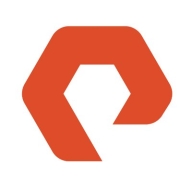


Find out in this report how the two All-Flash Storage solutions compare in terms of features, pricing, service and support, easy of deployment, and ROI.
By opting for the gold subscription every three years, you get a free upgrade to the latest controller release.
If you wait more than seven years to buy another one, you get a return on your investment.
We also had one outage where a controller of one of the products had failed and had to be replaced on-site.
Customers always have their issues resolved promptly.
Pure has good storage.
The support team is familiar with the product and is available on-site during support times, which improves our experience.
Dell solutions are backed by excellent service and support.
The technical support sometimes takes three to four days to get hardware to facilities.
It is highly scalable.
It is suitable for both medium-sized and enterprise businesses.
It hasn't broken down anytime in the last six to seven years, despite hurricanes, earthquakes, and power outages.
Dell Unity XT is quite scalable and can be scaled up to the petabyte level.
For NetApp, we can recommend the FAS 8000 series.
I rated the scalability as seven because even though the solution can scale, load balancing must be done manually, as it's not automated.
During the eight years, there have been no problems such as hardware failure or stopping.
I would rate the stability of the solution as a ten out of ten.
I would rate the stability of the product at seven out of ten.
I would rate the overall stability of Dell Unity XT an eight out of ten.
We would appreciate a built-in transparent failover in the next release to eliminate the need for a separate metro cluster.
I'm eagerly anticipating the roadmap's promise of introducing multiple controllers, which could significantly boost scalability and resilience.
We mostly rely on long-term releases. We don't need the most up-to-date features, but we need a reliable environment.
In the future, if Dell storages include this option, especially for Unity, it would help us target SME or medium enterprises for quicker closures and support the sales team.
I believe if Dell can integrate AI to predict potential failures, especially in hardware like hard disks, that would be very useful for proper maintenance.
The pricing is a bit higher than expected.
I suggest Nasuni improve their syslog forwarders to support TCP protocol, as it's more secure than UDP, which is plain text and not protected at all.
While the prices may be higher than those of other vendors, we see it as a market leader with benefits.
The support can be a bit pricey, but the solution is more cost-effective than anything else out there.
I would give it a nine out of ten in terms of costliness.
It is priced at around or under $50,000.
The cost is not cheap nor expensive.
Commercially, Dell Unity XT is viable and competitively priced.
I prefer solutions with lower pricing.
Pure Storage has signature security technology, which cannot be deleted, even if you are an administrator.
The platform's robust features include excellent sustainability tracking, and a comprehensive dashboard offering insights into IOPS, bandwidth, performance, and virtual activities.
Its data compression feature is the best that we have ever seen.
It helps with data cost management and is seen as a mid-range product with good performance.
We installed the Flash, which makes our IO operations fast and efficient.
If their growth is not significant, we might suggest mid-level Unity storage like Unity 300.
The features I find most valuable in Nasuni are the unlimited snapshots, antivirus capabilities, auditing, and ransomware protection.



| Company Size | Count |
|---|---|
| Small Business | 15 |
| Midsize Enterprise | 11 |
| Large Enterprise | 12 |
| Company Size | Count |
|---|---|
| Small Business | 61 |
| Midsize Enterprise | 49 |
| Large Enterprise | 94 |
| Company Size | Count |
|---|---|
| Small Business | 3 |
| Midsize Enterprise | 8 |
| Large Enterprise | 24 |
Pure Storage FlashArray//X is the world’s first enterprise-class, all-NVMe flash storage array. It represents a new class of storage – shared accelerated storage, which is a term coined by Gartner – that delivers major breakthroughs in performance, simplicity, and consolidation.
Dell EMC Unity XT is one of the best all-flash storage arrays on the market today. Dell EMC Unity XT arrays are designed for performance, optimized for efficiency, and built for a multi-cloud world. In addition, they support digital transformation, enabling businesses to reach the full potential of their data capital quickly and easily. Dell EMC Unity’s All-Flash and Hybrid Flash storage platforms provide the performance, efficiency, enterprise-class software, and virtualization integrations required for running a wide range of virtualized applications.
Dell EMC Unity XT Features
Dell EMC Unity XT has many valuable key features, including:
Dell EMC Unity XT Benefits
Some of the benefits of using Dell EMC Unity XT include:
Reviews from Real Users
Below are some reviews and helpful feedback written by Dell EMC Unity XT users.
A Systems Engineering Manager at a manufacturing company says, "It is definitely one of the most robust, solid, well-performing products that I have dealt with. It is set it and forget it, which is pretty amazing." He also mentions, “We can do both block and file storage on one unit without purchasing a separate device.”
Peter S., Senior Technical Specialist at a healthcare company, states, “The most valuable feature is reliability. At the end of the day, it just runs. This solution is easy to work with and easy to maintain.”
PeerSpot user Melvin T., Senior Systems Engineer at Prosperity Bank, explains that the solution is “easy to use and we can add LUNs or space without interruption to end-users. We're able to access it from just about anywhere, as long as we have access to a browser. That feature is really neat because sometimes we will go to a different data center or a different site, and if we need to access it to see a LUN or to see any type of storage, we can do that. That's one of the big takeaways with Unity."
Nasuni is a file data services enterprise focused on assisting firms with their digital transformation, global expansion, and information awareness. The Nasuni File Data Platform is a suite of cloud-based services designed to enhance user productivity, ensure business continuity, provide data intelligence, offer cloud options, and simplify global infrastructure. This platform and its auxiliary services are projected to replace conventional file infrastructure such as network attached storage (NAS), backup, and Disaster Recovery (DR), with an expandable cloud-scale solution. By storing file data in scalable cloud object storage from multiple providers, Nasuni positions itself as a cloud-native alternative for traditional NAS and file server infrastructure. Based in Boston, Massachusetts, USA, Nasuni serves sectors like manufacturing, construction, technology, oil and gas, financial services, and public sector worldwide, offering its services in more than 70 countries.
James J., IT Manager at a marketing services firm, says Nasuni’s management dashboard is helpful because he's able to view all of the different filers at once rather than check each one of them individually. He values the software’s security, reliability, good performance, helpful alerting, and responsive support.
According to a Server Engineering Services Lead at a mining and metals company, Nasuni offers good OR and DR capabilities, performs well, offers data security, and continuous file versioning helps recover from hardware failures.
The Managing Director of IT at a construction company appreciates Nasuni because it eliminates a lot of work that was previously done when managing backing up and restoring data files.
We monitor all All-Flash Storage reviews to prevent fraudulent reviews and keep review quality high. We do not post reviews by company employees or direct competitors. We validate each review for authenticity via cross-reference with LinkedIn, and personal follow-up with the reviewer when necessary.